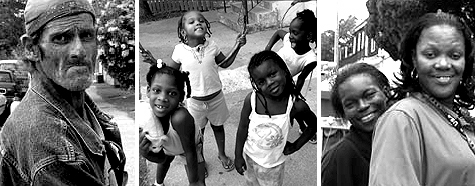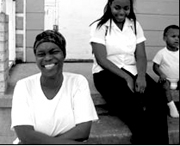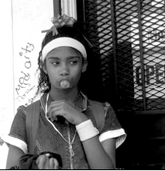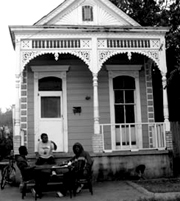
Our stories, told by us:
New Orleans teens write books about lively neighborhoods now lost
by Abe Louise Young
Just weeks before levee breaches flooded New Orleans in 2005, six African-American teenagers organized three block parties. The music, speeches, and dancing in the streets celebrated a victory few in their neighborhoods had claimed before: book publication. These weren't just any old books. Their young authors documented the people and places that had raised them, through thick and thin, in New Orleans' poorest neighborhoods. The Neighborhood Story Project books became best sellers in the city overnight.
The jubilation ended quickly, as Hurricane Katrina's aftermath dispersed those communities across the nation. The unique social fabric documented in the texts was lost in a day. Yet the stories hold memory, provide continuity, and a possibly offer a map to return with. They provide an example of the power of literacy, and of teaching that honors young people's knowledge. When the skills of reading, writing, and analysis are brought to bear on students' actual lives, transformation can happen for whole communities.
Sociological imagination
The Neighborhood Story Project began in 2004. Rachel Breunlin and Abram Himelstein were disillusioned Writing teachers at John McDonogh High School. Like many New Orleans public schools, it demonstrated less than 20 percent proficiency in English and Math skills—and 75 percent of the student body lived below the poverty line. Certain there was a better way to teach, the pair decided to create their own writing program—outside of school. They invited teenagers to spend a year writing autobiography, taking pictures, and interviewing their neighbors.
 The young writers were paid $1,000 each for their participation. They met each afternoon in an apartment near the school. Visiting poets and photographers came in as guest instructors. The group read classic texts like Sandra Cisneros's The House On Mango Street. As part of their job, the students taught poetry workshops for third- and fourth- grade students at a nearby elementary school.
The young writers were paid $1,000 each for their participation. They met each afternoon in an apartment near the school. Visiting poets and photographers came in as guest instructors. The group read classic texts like Sandra Cisneros's The House On Mango Street. As part of their job, the students taught poetry workshops for third- and fourth- grade students at a nearby elementary school.
As their books emerged on paper, participants learned editing, revision, and the many shapes a manuscript takes on the way to publication. They got feedback from the family members and neighbors they profiled. They determined their ideal audiences. "If I could pick anyone to read my book, I think it would be my mom and my neighborhood, because they are my book. Every page and every story I wrote was for them," Ashley Nelson writes in The Combination.
Over the yearlong process, the young writers developed what C. Wright Mills calls "sociological imagination," the ability to connect their personal autobiographies to larger issues of history. In addition, they wrote some amazing books.
Literacy in the urban southern landscape
New Orleans is a city famously rich in certain literacies, like celebration, cooking, and conversation. The literacy of knowing every person on every porch in a two-mile radius, or how to brown oil and flour into a just-right roux, is commonplace genius. But learning to read and write has never been easy.
 That's one of the reasons behind the Neighborhood Story Project's success. Plenty has been written about the city's struggling communities, but little has been written from within, for an audience of peers. By portraying both the beauty and the struggles of life around them, the six young authors of the Project put into print realities that have simply never been printed before.
That's one of the reasons behind the Neighborhood Story Project's success. Plenty has been written about the city's struggling communities, but little has been written from within, for an audience of peers. By portraying both the beauty and the struggles of life around them, the six young authors of the Project put into print realities that have simply never been printed before.
Their stories are as gritty as they come, yet leavened by humor and free from sentimentality. Waukesha Jackson interviews her mother about when she started smoking crack, and how it felt to leave her children alone for days while she did. Together, they test a beginning forgiveness in Jackson's book, What Would the World Be Without Women: Stories from the Ninth Ward.
In Before and After North Dorgenois, Ebony Bolding examines the changing demographics of her block. She interviews new people moving into her community, talks to old-timers on their porches, and articulates her own anxiety about moving into a different neighborhood. She writes of her mother's hard work to raise her, and the family's sadness when her brother is badly beaten by police.
Brother and sister team Arlet and Sam Wylie talk about life above a bustling neighborhood store in Between Piety and Desire. In Palmyra Street, Jana Dennis looks at her family's religious life, and their participation in the Golden Arrows Mardi Gras Indian Tribe.
In the Lafitte housing project, Ashley Nelson interviews gang members, family members, men collecting aluminum cans, and vendors of pigs' feet and sour pickles. She describes what it's like to wake up without food, and to go to her mother's funeral at age fourteen. She recounts fun times spent free-styling to cellphone ring tones, and lists the names of loved ones who have died. She writes out her gratitude for all many community members who helped her get through childhood.
 When Hurricane Katrina broke these neighborhoods apart, an extraordinary thing happened. Isolated in many corners of the country, neighbors got into contact with each other—through the axis of the Neighborhood Story Project.
When Hurricane Katrina broke these neighborhoods apart, an extraordinary thing happened. Isolated in many corners of the country, neighbors got into contact with each other—through the axis of the Neighborhood Story Project.
Unlocking the world
The Neighborhood Story Project guides students to "see literacy as a means for reading the world, building their own creative projects, and becoming agents of change." It is clear that the young writers take this aim to heart. Ashley Nelson ends her book by passing the message on: "When you read my book, don't feel sorry for me because I don't need it....Ya know what? If you feel me, figure out your own combination and unlock the world."
Today, Nelson is back in New Orleans. She works as a teacher for the Neighborhood Story Project. Each of the other student writers survived the Hurricane; they are living with their families in different cities around the country. And as schools in New Orleans slowly reopen, Breunlin and Himelstein prepare to go into classrooms, and find the next authors of history.
Click below to:
Read excerpts from two student books.
Read an interview with Abram Himelstein, co-founder of the Neighborhood Story Project.
Visit the Neighborhood Story Project website, or to purchase their books.
Return to "It's hip to be deep: Making writing essential to teens' lives."